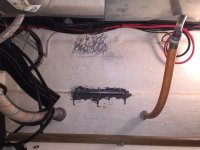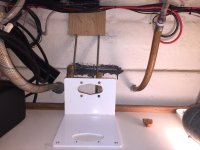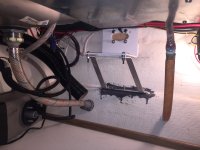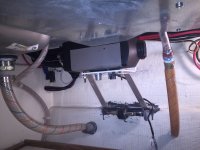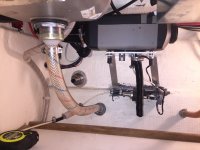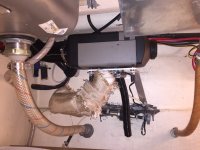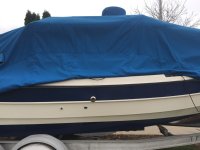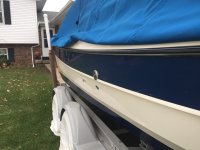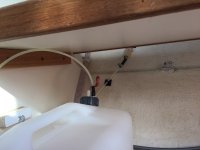brooks&judy
New member
- Joined
- Aug 18, 2015
- Messages
- 37
- Reaction score
- 0
- C Dory Year
- 2006
- C Dory Model
- 22 Cruiser
- Vessel Name
- Ticket
`Seems you're going about your furnace installation smartly, but perhaps for one thing - the high heat outlet. Maybe you've thought of all this and decided the vent behind the pilot seat's right for you. Here's another perspective:
In my 22' Cruiser the furnace is mounted under the galley, the heat ducted through a Y-fitting, one leg of ducting then run to an outlet down by the cabin sole to blow on your feet when at the galley stove or to rise and warm someone sitting across at the table. The other leg of the ducting runs to an outlet adjustable for direction and volume exiting athwartship from under the pilot's feet.
These low outlets mean you're warm from your feet up, not just hips-up ~ a complaint I hear Wallas stove owners express since their heat also enters the cabin at hip-level. The adjustable outlet on our forward duct lets us direct heat up to the V-berth or across to rise around someone sitting in the passenger seat. Cracking open a window a bit helps draw the heat to whichever side.
Shutting off the forward outlet will send more heat out the aft outlet, good for warming the cockpit too when all the 'camper-back' canvas is snapped in.
With the longer ducts secured against bulkheads in the cabinets, they take up little space. I can't take credit for this smart setup: It was this way when I bought the boat from C-Brat Barry Daniel.
In my 22' Cruiser the furnace is mounted under the galley, the heat ducted through a Y-fitting, one leg of ducting then run to an outlet down by the cabin sole to blow on your feet when at the galley stove or to rise and warm someone sitting across at the table. The other leg of the ducting runs to an outlet adjustable for direction and volume exiting athwartship from under the pilot's feet.
These low outlets mean you're warm from your feet up, not just hips-up ~ a complaint I hear Wallas stove owners express since their heat also enters the cabin at hip-level. The adjustable outlet on our forward duct lets us direct heat up to the V-berth or across to rise around someone sitting in the passenger seat. Cracking open a window a bit helps draw the heat to whichever side.
Shutting off the forward outlet will send more heat out the aft outlet, good for warming the cockpit too when all the 'camper-back' canvas is snapped in.
With the longer ducts secured against bulkheads in the cabinets, they take up little space. I can't take credit for this smart setup: It was this way when I bought the boat from C-Brat Barry Daniel.


